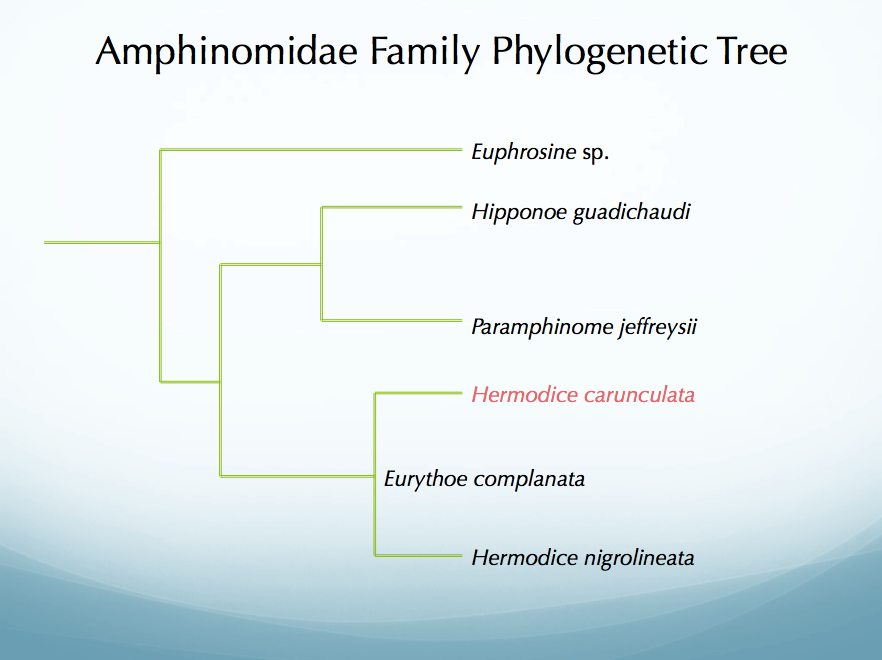Classification
Domain: Eukarya.jpg)
Kingdom: Animalia
Phylum: Annelida
Class: Polychaeta
Order: Aciculata
Family: Amphinomidae
Genus: Hermodice
Species: Hermodice carunculata (Pallas, 1766)
Hermodice carunculata is
classified as in the Domain Eukarya because it is an organism with
cells which contain a nucleus and organelles. It is under the
Kingdom Animalia because it is a heterotrophic, multicellular
organism lacking cell walls, and is motile at some stage of life.
The bearded fireworm is in the Phylum Annedlida because it is a
segmented worm. H. carunculata is put under the Class
Polychaeta along with other bristleworms because they are chaetae
bearing, which are sharp protusions from the skin. It belongs to the
Order Aciculata because it bears aciculae, a certain type of
chaetae, along wiht ventral sensory palps and cirri. Hermodice
carunculata is classified in the Amphinomidae Family because it
is a jawless polychaete with a specific chaetal structure, and it
has a caruncle. The Genus Hermodice refers to the bearded
fireworms whom feed on coral in reef habitats throughout hte
Caribbean, Mediterranean, and Atlantic.
The meaning of the scientific name Hermodice
carunculata refers to caruncle, which is a sensory organ that
extends over the fireworm's mouth, and the root her- refers to
attach. The scientific name can be interpreted to mean "attachs via
caruncle."

The phylogenetic tree shown above represents the
Amphinomidae Family was created using information from "A molecular
phylogeny of annelids" and "The curious case of Hermodice
carunculata (Annelida: Amphinomidae): evidence for genetic
homogeneity throughout the Atlantic Ocean and adjacent basins." The
Amphinomidae family consists of two main groups and around 200 named
species; the major groups are Amphinomidae, fireworms, and
Euphrosinidae, represented by Euphronsine sp. on the tree.
The most closely related family is Chaetopteridae, but there is
little to no support for this relationship (Rousset et al. 2003).
The closest relatives to Hermodice carunculata are from the
genus Eurythoe and the genus Hermodice:
Hermodice carunculata and Hermodice nigrolineata
(Arias et al. 2013; Ahrens et al. 2013).
Eurythoe complanata is not placed on the end of a branch
because it is actually two identical organisms found in different
environments, so it has not officially found a place on the
phylogenetic tree (Arias et al. 2013). Until recently,
Hermodice nigrolineata was actually thought to be a junior
synonym of Hermodice carunculata, but it has been
discovered that they have multiple differences including number of
branchial filaments (Ahrens et al. 2013). Less information
is known about Hipponoe guadichaudi and Paramphinome
jeffreysii and their relationship to Hermodice carunculata.
In conclusion, Hermodice carunculata is not the only
fireworm in the big blue ocean.
